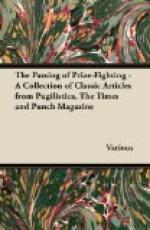But though public investigation of geological truth is for a time at a stand-still, we are glad to be able to record the following remarkable instance of private enterprise:—
A very active member of the association—the indefatigable Mr. Grubemup—determined to leave no stone unturned for the purpose of making observations, went out, attended by a single assistant, and made a desperate attempt to turn the mile-stone in the Kensington-road, in the hope of finding some geological facts at the bottom of it. After several hours’ labour before day-break, to avoid interruption from the police, he succeeded in introducing the point of a pickaxe beneath the base of the stone; and eventually he had the satisfaction of removing it from its position, when he made the following geological observations:—He found a primary deposit of dark soil, and, on putting his spectacles to his eyes, he distinctly detected a common worm in a state of high salubrity. This clearly proved to him that there must formerly have been a direct communication between Hookham-cum-Snivey and the town of Kensington, for the worm found beneath the milestone exactly resembled one now in the Hookham-cum-Snivey Museum, and which is known as the vermis communis, or earth-worm, and which has always excited considerable interest among the various visitors. Mr. Grubemup, encouraged by this highly satisfactory result, proceeded to scratch up with his thumb-nail a portion of the soil, and his geological enterprise was speedily rewarded by a fossil of the most interesting character. Upon close inspection it proved to be a highly crystallised rat’s-tail, from which the geologist inferred that there were rats on the Kensington-road at a much earlier period than milestones. We have not heard that the ingenious gentleman carried his examination further, but in the present state of geology, any contribution to the science, however small, will be thankfully received by the knowledge-loving community.
* * * * *
LAYS OF THE “BEAU MONDE.”
BY THE EDITOR OF THE MORNING POST.
I saw at Lord George’s rout,
Amid a blaze of ton;
And such a tournure ne’er
“came out”
For Maradon Carson!
For who that mark’d
that sylph-like grace
That full Canova hip,
That robe of rich Chantilly
lace,
That faultless satin slip,
Could doubt that she would
be the belle
To make a thousand waistcoats swell?
I saw her seated by my lord,
As joli comme un ange;
She took some pate perigord.
And after that blanc mange:
A glass of Moyse’s pink
champagne
Lent lustre to ses eux.
And then—I heard
a Grisian strain—
It was her sweet adieux;
And I—my friend
the butler sought,
To slake with stout each burning
thought.




